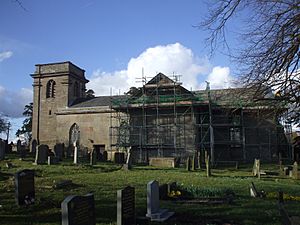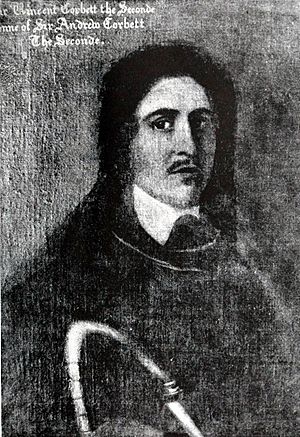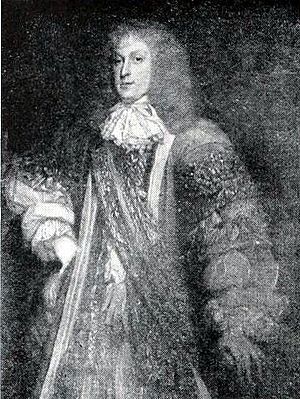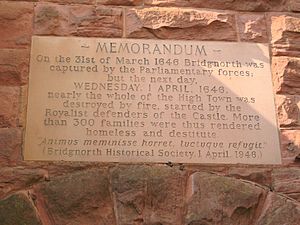Sir John Corbet, 1st Baronet, of Stoke upon Tern facts for kids
Sir John Corbet (born 1594 – died 1662) was an English politician. He represented Shropshire in the House of Commons during the Long Parliament. He was a moderate Puritan, a group of Protestants who wanted to make the Church of England simpler. Before the English Civil War, he was known for fighting against taxes the king tried to collect without Parliament's approval. He also had a long disagreement about who controlled his local church in Adderley, which led to him being put in prison.
During the Civil War, he was an important member of the Shropshire county committee. This group was in charge of fighting against the Royalists, who supported the king. Sir John was part of a group in Parliament who believed in Presbyterianism, a type of church organization. Because of this, he was removed from Parliament during an event called Pride's Purge. After the king was restored to power in 1660, Sir John lost his public jobs.
Contents
Family Background
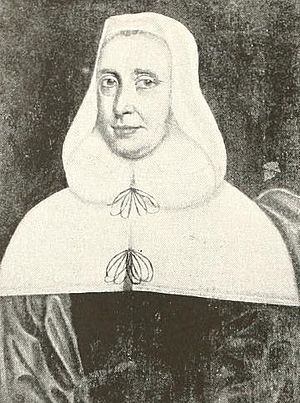
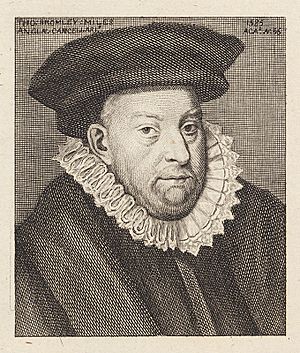
John Corbet came from a well-known family of landed gentry in Shropshire. This meant they owned a lot of land. Both his parents came from Protestant families who had become wealthy through law, business, and connections at the royal Court.
His father was Richard Corbet of Stoke upon Tern and Adderley, Shropshire. This part of the Corbet family came from the Corbets of Moreton Corbet Castle. Richard's father, Reginald Corbet (who died in 1566), was a very important judge and John's grandfather. Reginald became rich not only from his legal work but also by marrying a niece of Rowland Hill, a very wealthy businessman. Rowland Hill was the first Protestant Lord Mayor of London. Most of the family's land in north Shropshire came from Hill's gifts.
His mother was Anne Bromley. She was the daughter of Sir Thomas Bromley, who was also from Hodnet, the same place Rowland Hill was born. Bromley was another famous lawyer. He was the Lord Chancellor from 1579 to 1587, which meant he was a top legal official. He was even in charge of the trial of Mary, Queen of Scots. He became very rich and bought large estates in other counties.
Early Life and Education
John Corbet was born in Stoke upon Tern and was baptized on May 20, 1594. He was the second son of his parents. His older brother, Richard, was supposed to inherit the family lands. John also had a younger brother named Thomas.
Their father died in 1601. Richard, the oldest, took over the family estates. John likely received the usual education for younger sons in the Corbet family. This meant going to university and then studying law. A John Corbet graduated from Cambridge University in 1612, which might have been him. He definitely studied law at Lincoln's Inn in 1615.
John's older brother, Richard, died in 1615. Richard had two sons, but only one, also named Richard, survived him. Because of a special arrangement in his brother's will, John became the owner of the family estates by 1618. Neither his nephew nor his brother's widow ever challenged this.
In 1620, John Corbet married Ann Mainwaring from Ightfield. He was made a baronet on September 19, 1627. This was a special title given by the king. He also became a justice of the peace (a local judge) and was chosen as High Sheriff of Shropshire for 1628 to 1629. However, these were times of growing political problems. Corbet began to strongly oppose the policies of King Charles I and his government.
Fighting Against the King's Power
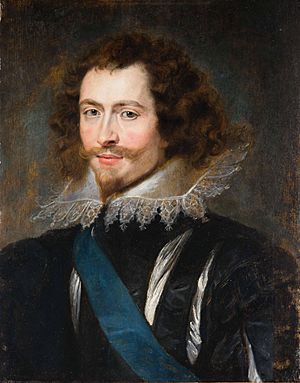
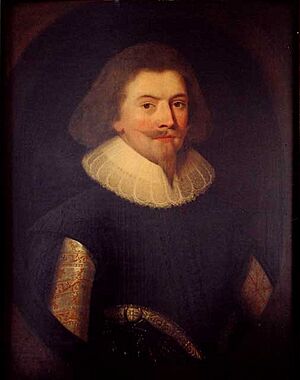
In 1627, Sir John Corbet led the opposition in Shropshire against the "Forced Loan." This was a tax the King demanded without Parliament's approval. The Parliament of 1625 had refused to fully pay for the war against Spain. When the king also started a war against France, he decided to collect money without asking Parliament. Corbet spoke out strongly against this Forced Loan.
Even though the tax collection in Shropshire was quite successful, Sir John Corbet's protests seemed to influence his cousin, Sir Andrew Corbet. Sir Andrew had been collecting the loan, but after that, he joined Sir John in opposing the king. He voted for the Petition of Right in the Parliament of 1628. This petition limited the king's power.
Corbet continued to fight against the king's power during the 11 years when Charles I ruled without Parliament. This period was known as "Thorough." In 1634, Corbet strongly criticized "Ship money," another tax the king imposed without Parliament's consent.
A big debate happened on April 7, 1635, in Shrewsbury. It was about the king's right to charge fees to pay the muster-master, who trained the county's local army, called the militia. The local jury said these charges were "a great grievance and oppression." A lawyer named Timothy Tourneur, who worked for John Egerton, 1st Earl of Bridgewater (the Lord Lieutenant of the area), immediately disagreed. Tourneur said the jury was getting involved in things that weren't their business.
Corbet and another man named Robert Charlton defended the jury and attacked Tourneur. Corbet demanded that the Clerk of the Peace read out the part of the law that referred to the Petition of Right. Most of the local judges supported Corbet. However, the incident was reported to the king's Privy Council of England through Bridgewater.
Corbet was called before the council and accused of "making speeches to his Majesties disservice and the animating of others to refuse the payment." Because he stood his ground, he was imprisoned on June 10. He was held in the Fleet Prison for six months but was never brought to trial. Charlton, his friend, was only jailed for two days.
Corbet's strong opposition to these taxes earned him the nickname "the Patriot." In June 1641, the House of Commons agreed with Corbet. They said that the tax for the muster-master was illegal and against the Petition of Right. The House also declared that Corbet's imprisonment was illegal. They said he should be paid back by those who ordered his arrest.
The Adderley Church Dispute


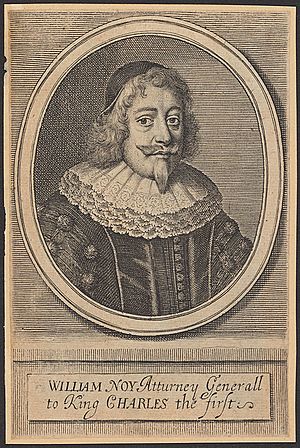
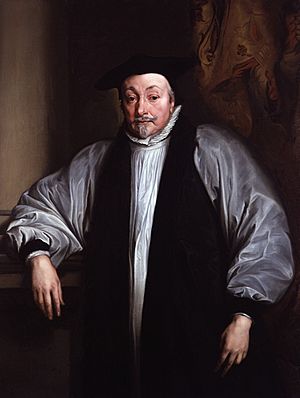
Sir John Corbet had a long-running argument with his neighbors, the Needhams of Shavington Hall. This dispute was about who controlled and used St Peter's Church, Adderley. While it seemed like a fight over honor, it was also about the direction of the Church of England. The Needhams were Royalists and supported the "High Church" style, while the Corbets were Parliamentarians and Puritans.
There was already bad feeling between Corbet and Robert Needham, 1st Viscount Kilmorey, his neighbor. Needham's main lands were in Cheshire, but he also owned land in Shropshire, where he was politically active. His home was Shavington Hall, which was in the parish of Adderley. Corbet was the lord of the manor and had the right to choose the church's priest.
Problems started because Needham was unhappy with his place in the church. Corbet, as the patron, had a special seat in the chancel (the area near the altar), facing the priest. Needham, as a regular church member, was expected to sit in the main part of the church, the nave. The priest gave up his seat to the Needhams, but Needham still wanted a special place in the chancel by right.
Needham asked Thomas Morton, the Bishop of Lichfield, for permission to rebuild his private chapel. Private chapels were not popular at the time, as people were expected to attend their parish church. This raised suspicions that the Needhams might secretly be Catholic. The bishop allowed the chapel to be rebuilt in 1629.
Eight months later, Corbet started a lawsuit to have the chapel's consecration (blessing) declared invalid. He partly succeeded. The consecration was declared invalid "in its plenary sense," but the chapel was still allowed for normal Anglican worship.
When Robert Needham's son, Robert Needham, 2nd Viscount Kilmorey, took over in 1631, he tried to get the consecration fully restored. A special group met and overturned the earlier decision. Corbet responded by burying his deceased servant four feet above the late Lord Kilmorey in the church's chancel. Kilmorey asked Thomas Howard, 21st Earl of Arundel, a high-ranking official, to step in. Arundel saw it as a dispute over who was more important and ordered Corbet to dig up his servant's body.
Even after this victory, Kilmorey pushed further. He demanded to build a family burial chapel in an aisle or transept (a wing) of Adderley church. William Noy, the Attorney General, advised him that this needed the consent of the Bishop, the Patron (Corbet), the priest, and the church members. Since Corbet would never agree, Kilmorey waited until 1635, when Corbet was in prison. He then asked the king directly. Archbishop William Laud, who was trying to make the church more uniform, happily gave Kilmorey permission. The transept was built by 1637.
However, on March 6, 1642, while Corbet was in Parliament, his wife and children took over the Kilmorey chapel. On March 30, four of Corbet's armed servants stopped Kilmorey's family from using their seats. On May 8, Ann Corbet sent 20 armed men to secure the church before her family went into Kilmorey's chapel. In the afternoon, she did it again with an even larger group. Kilmorey asked Laud for help, but it was too late. Corbet had the protection of Parliament, and Laud had already been put in prison. The issue then became part of the English Civil War, where Corbet and Kilmorey fought on opposite sides.
A Parliament Supporter
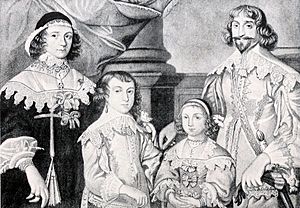
Sir John Corbet was elected as a Member of Parliament for Shropshire in the Long Parliament. After the king tried to arrest five Members of Parliament in January 1642, Parliament wanted to control the local army (militia). Corbet presented a petition from Shropshire about this to the House of Lords. He was one of the MPs chosen to talk with the king to try and avoid war.
In March, both Houses of Parliament passed the Militia Ordinance. This law put the militia under Parliament's control and said it was valid even without the king's agreement. The king responded by setting up his own military groups, called Commissions of Array. This effectively divided the country into two armed sides. In the summer, Parliament outlawed the king's commissions and sent out their own to enforce the Militia Ordinance. Corbet and two other members were sent to Shropshire to explain Parliament's position and ask for support.
Royalists Take Control of Shropshire
Corbet's mission to Shropshire initially received a good response. The Drapers' Company in Shrewsbury gave a lot of silver, money, and equipment. However, things quickly went wrong. A Parliamentarian gathering on August 1 was broken up by Royalist gentry. The next day, Royalist forces drilled at Atcham under Sir Vincent Corbet, 1st Baronet, who was a relative of Sir John but supported the king.
Sir Richard Lee, Corbet's fellow MP for Shropshire, was removed from Parliament for supporting the king's commissions. The king then set up his standard (a flag showing his presence) at Nottingham on August 23, marking the start of the Civil War. Shrewsbury council declared they would not resist on August 30, giving the Royalists control of the county. The king's army occupied Shrewsbury on September 20.
The Royalist troops were often unpaid and started looting, which hurt the king's cause. The king also made lists of local Parliamentarian and Puritan leaders to be punished. Corbet and his friends were effectively forced out of their home county.
The Shropshire County Committee
In the spring of 1643, Parliament began to plan to take back the West Midlands. In February, Corbet was made a colonel of forces to be raised in Shropshire. He was also named as a commissioner for Shropshire to take money and property from "notorious Delinquents," meaning Royalist supporters.
The group of people in charge of carrying out Parliament's laws in Shropshire became known as the Shropshire County Committee. It included Corbet, along with others like Thomas Hunt, the MP for Shrewsbury, and Robert Corbet of Stanwardine, Sir John's cousin. In April, this committee joined with similar groups in Warwickshire and Staffordshire.
Progress was slow at first. However, the Shropshire Committee got help from Sir William Brereton, 1st Baronet of Cheshire. In September, they gained a foothold in the county at Wem. From there, they set up a smaller base at Stoke upon Tern, Corbet's home. They later stormed Moreton Corbet Castle. Sir John Corbet himself spent much of his time in London during the fighting.
The Presbyterians' Struggle
Corbet was part of a "middle group" in the House of Commons. They wanted a Presbyterian church system and peace. However, events moved quickly beyond this group as the war continued. In February 1645, Shrewsbury was taken by Parliamentarian forces and put under the control of Humphrey Mackworth. Nationally, Parliament gained a decisive advantage with the victory at the Battle of Naseby in June. Royalist strongholds in Shropshire fell one after another. Corbet's son, also named John, fought for the Royalists. He was present when Bridgnorth fell in March 1646, and the Royalist soldiers burned the town.
The Presbyterians seemed to achieve their goal in January 1647. Changes to church organization and worship, planned by the Westminster Assembly, were put into effect. The Directory of Public Worship replaced the Book of Common Prayer. Shropshire was one of only eight counties that tried to implement this new system. Corbet was named as a leader for one of the eight "classes" (church districts) in the county. This district, which included Wem and Whitchurch, was probably the only one that became fully active.
However, events quickly turned against the Presbyterians nationally. The army and other religious groups, called Independents, became impatient. In December 1648, an event called Pride's Purge removed the Presbyterian majority from Parliament. This cleared the way for the trial and execution of Charles I. Corbet was one of those removed from Parliament.
Later Years and Death
Sir John Corbet's role in public life became smaller after this. In August 1649, when Parliamentarian troops were staying in north Shropshire, riots broke out. Corbet was appointed to a committee responsible for supporting Parliament's forces in the county. He also served as a council member in Shrewsbury. He likely continued to be important in his local Presbyterian church district, which lasted long after the dream of a national Presbyterian church ended.
At the Restoration of Charles II in 1660, Francis Lord Newport was appointed Lord Lieutenant of Shropshire. He was responsible for removing Parliament supporters and religious dissenters from public office. Newport was bothered by the continued operation of Corbet's church district. He took steps to remove Presbyterian ministers whenever possible.
Early in 1662, Sir John Corbet and others who refused to take an oath against the Solemn League and Covenant (a past agreement with Scotland) were removed from Shrewsbury council. This was followed by a thorough removal of Presbyterian clergy.
Corbet died in June 1662 at the age of 68. He was buried in the chancel of the parish church at Market Drayton, Shropshire.
Marriage and Family
Corbet married Anne Mainwaring, daughter of Sir George Mainwaring of Ightfield, around 1620. Sir George was also a major landowner. Anne Mainwaring was his only daughter. She outlived her husband, Sir John Corbet, by more than twenty years. Her strong personality and firm support for Parliament and the Puritan cause earned her the nickname "the Good Lady Corbet."
Sir John and Lady Anne had many children. Seventeen of their children reached adulthood. They included:
- Sir John Corbet (1619-64), who became the second Corbet baronet of Stoke. He married Lettice Knollys. He died only two years after his father, and his son, also named Sir John Corbet (1642-95), inherited the title.
- Vincent Corbet (1621-54) married Elizabeth Church. He was a cavalry captain for Parliament and died without children.
- Margaret Corbet (b.1625) married Sir William Stafford. He took part in a Royalist revolt and was an MP after the Restoration.
- Grace Corbet married Sir William Pulteney of Westminster, a wealthy London businessman. He was a Royalist in the Civil War and later became an MP.




